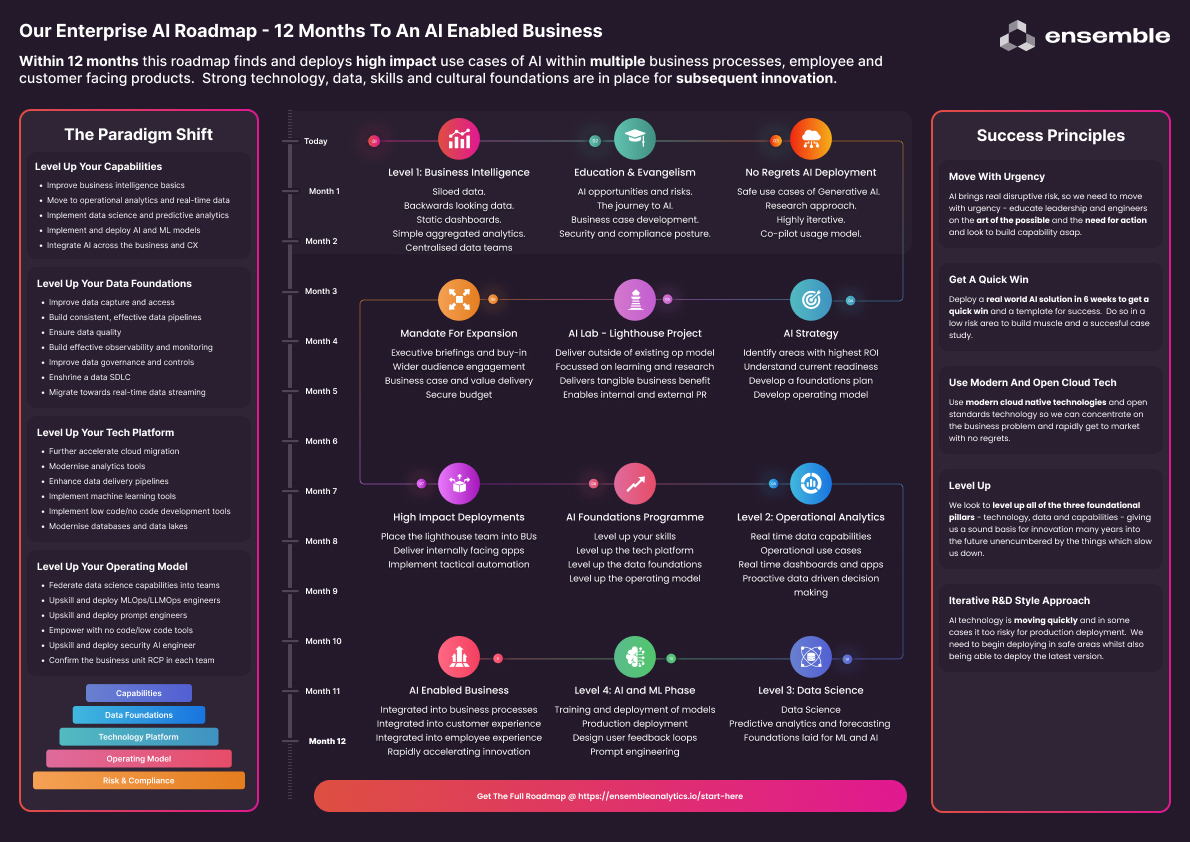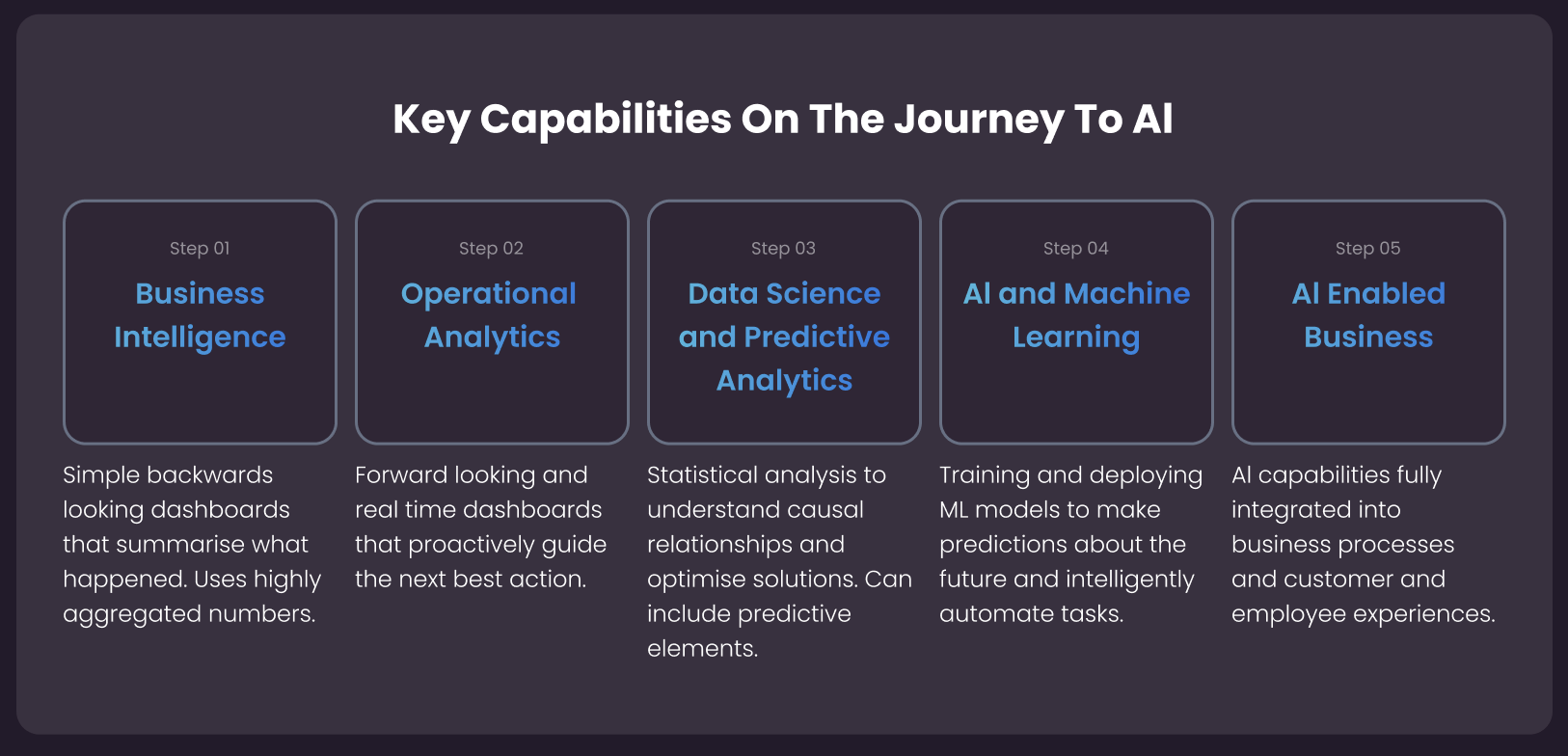General
20 Mar 2024

Though AI has been around for decades, it experienced a massive uptick in interest in November of 2022 with the release of ChatGPT.
At that point, every business large and small immediately began to think about how they could make use of large language models and AI more broadly. This included the obvious use cases such as better customer facing chatbots, but also more ambitious projects such as back office process automation.
Since then, enterprises have been executing many proof of concept projects in order to understand how they can make use of this technology and how well it performs in reality.
However, where we go after these POC's is less obvious. Where best can this technology be applied? How real are the risks relating to copyright or hallucinations, and how do we guard against them? What software platforms need to be deployed, and what skills are needed in this new world? How much will it cost and what will the likely return on investment be?
In short, businesses today are looking for a roadmap or a strategy for the scaled adoption of AI. This is something we have spent a long time thinking about and developing, but collectively as an industry, we are only in the earliest days of working out the answers and testing the approach:

In a small business, questions such as the above can be resolved around a table on a case by case basis. For a large enterprise however, these questions are more complex and they need to approach it much more strategically.
Firstly, large established enterprises have more complexity and more legacy. This means that implementing AI tools and related change is much harder than startup and scaleup businesses who have more of a greenfield environment and modern technology stack.
Large enterprises typically carry more risk such as reputational risk and compliance or regulatory risk if things go wrong. This means that they have to move forward cautiously and with appreciation for the environment in which they operate.
From a business case perspective, implementing AI and Machine Learning at enterprise scale will likely cost more in terms of tools and manpower, but the return on investment could likewise be correspondingly greater.
And implementing process change could require taking multiple people on the journey, training them in new approaches, and getting their buy-in and support even where they feel threatened by the change.
In short, the landscape is much more complex and the stakes are much higher for large regulated businesses, and it's worth moving forward in a more measured and considered way.
Considering this complex environment, how do we recommend that businesses move forward into the scaled adoption phase of AI?
In the remainder of this article, I wanted to broadly talk through this journey as we are proposing with our clients. Of course every business is different, but we think that the principles are generically applicable.
We hope that this framework will help businesses as they think about their own journey and develop their strategy.
I believe that educating stakeholders is the most important component of any transformation like this. This includes the leadership, on-the-ground employees and engineers.
Firstly, there is considerable noise relating to AI, and people need to understand its actual capabilities. Though they are impressive, large language models in particular are still in their infancy, and they are not always predictable and have only a medium level of reasoning ability. The first step is to learn what they can actually do and what will be coming online tomorrow.
A great way to do this is by surveying the vendor market and asking them to prepare presentations using your own anonymised data. You may need to invest in some small POCs with these vendor partners, but you will learn a lot in a short space of time. I would also look to work with large strategic vendors such as AWS who have the scale to become genuine innovation partners without pushing for a quick sale.
For larger enterprises, there also needs to be a strong understanding of risk and compliance requirements. Though I am as keen as anyone to innovate and experiment with these new tools, there is considerable risk relating to issues such as legal liability and copyright. It is essential that businesses understand this playing field and learn about the security and guardrail tools which can be used to reduce this risk and implement AI safely.
Finally, I think it's critical to take your own engineers on the journey and begin to upskill them. You can't buy AI as a product, and to buy it from an external system integrator is also a mistake for something as fundamental as this. Finally, you will also struggle to find skills in the market so it's not even something that can be hired in. The only viable alternative therefore is to upskill your own people who are already familiar with your business, and you need to start this process early.
There are a number of use cases of AI and Large Language Models which I describe as no-regrets and low risk ways to get started.
For instance, using external tools such as ChatGPT for tasks like research, translating documents or re-formatting documents can be an instant aid to productivity across a large pool of employees if appropriate data safeguards are put into place.
Next, internal co-pilots and knowledge bases are a great way to build muscle with this technology and secure an internal case study of its success whilst stepping up the level of complexity.
Using coding co-pilots to make developers more productive also seems a fairly safe usage model to lean into this world as LLMs are very strong in this area.
More complex internal deployments used for back office process automation could be positioned as a tool which can help employees make decisions and support their productivity. Employees should understand the failure modes and begin to use them as an experimental tool rather than handing over decision making to the AI.
It's likely the case that your employees are doing all of this anyway as shadow IT, so why not bring these low risk use cases into the light and formalise their use so it can be done in a more governed and controlled way?
It is relatively easy to begin to use Large Language Models, as they are provided as APIs from organisations such as OpenAI, AWS, Microsoft and Google.
However, if you are going to implement bespoke AI and machine learning solutions at greater scale then you need to have a number of foundational components in place. If you don't have them, you'll continually hit friction such as poor data quality, inadequate tooling, compliance challenges and hundreds of other objections which can damage confidence in what you are trying to do.
The first priority should be getting the right data foundations in place. This includes extracting data from application systems, bringing it in from partners, organising it in some data warehouse or data lake, and making it ready for consumption by machine learning models in a clean, governed format with strong data lineage.
There will also be foundational technology work, such as implementing machine learning platforms, observability tools and data engineering pipelines to manage and continually deliver your data.

Many businesses today only have "business intelligence" in place, where they are doing aggregated analysis against data warehouses using tools such as SQL, and presenting the findings on static dashboards and reports.
If you aspire to integrate AI and Machine learning in multiple parts of your business, you need to build new skills such as real-time data, data science and machine learning capabilities.
To do so requires hiring new skills into your business, installing new tools, and building new environments for model development, training and inference. You may also need to implement new functions and processes in your business to enable this end to end process.

With transformations like this, there is a risk that people think it's solved by buying a tool. If we buy Snowflake or Databricks or invest in GCP then we are "doing AI" and the box is ticked.
I believe that to get the most out of any change like this, you need to change how you work. This can be more impactful than any tool could ever hope to be in isolation.
This operating model change potentially includes changing roles and responsibilities to reflect the new world, bring in new skills and job roles, moving people out of centralised teams and into new structures, and changing processes within or outside of IT to execute on the opportunity.
With any transformation of this kind, a success story is the most powerful tool you have in your arsenal. If you can show that AI was attempted in your business and genuinely led to revenue growth or cost savings, you will have the attention of most of your business.
To achieve this, we like to execute a lighthouse project. This involves delivering a real world project, sometimes in a semi-artificial setting, for the purposes of learning and delivering something successfully. The main output of this project is this success story.
This successful case study is used as a PR vehicle internally to show that it can work, and could also be shared externally to attract scarce new skills into the business.
The lighthouse project and the overall success story is particularly important with AI, because there will be a lot of doubters and many objections. In addition, people sometimes struggle with visualising real use cases so it's very important to deploy the techniques within a domain which people in your business actually understand.
At this point, you should have the right foundations in place. Your data will be in a good place, your tools will be ready, your teams and processes will be setup in the right way, and you will have one or two successful lighthouse projects to build your narrative around.
We are then faced with the challenge of scaling this across the business, potentially into hundreds of business processes, applications and customer facing experiences where ROI exists. This could span into multiple years of work and ongoing refinement, but the aim is to over time integrate advanced analytics, machine learning and AI right across the business to enable a business genuinely enabled by AI and intelligent automation.
As we suggested, adopting AI in a large complex enterprise is a transformation programme which has deep implications across your business.
This doesn't mean you can't start with some low risk deployments to build muscle, but I think that we are now at the point where businesses need to think about this strategically as there is potentially a large programme of change which will need to be planned, funded and carried out over the next few years.
If you would like to learn more about this, please download our free report which describes this journey to AI in much greater detail, or reach out for an informal discussion.